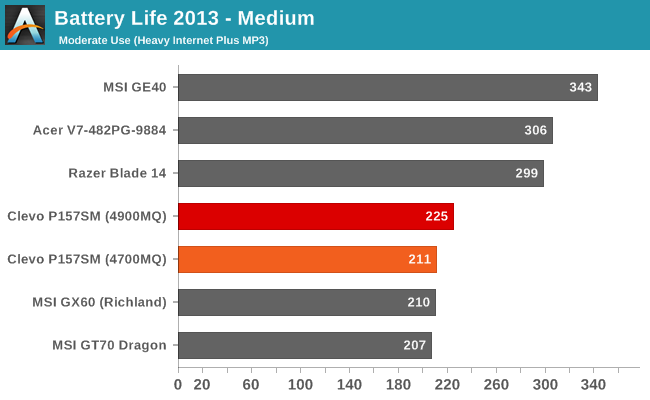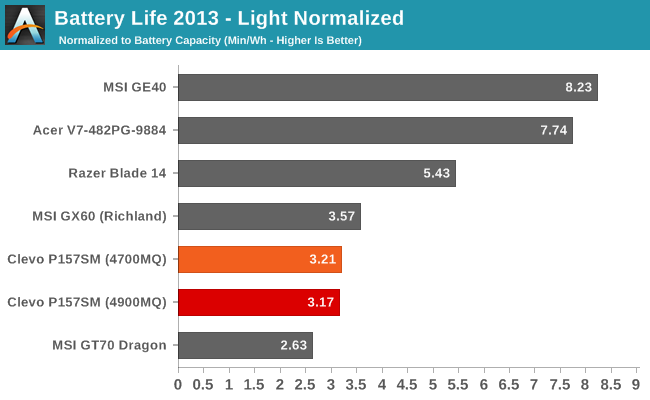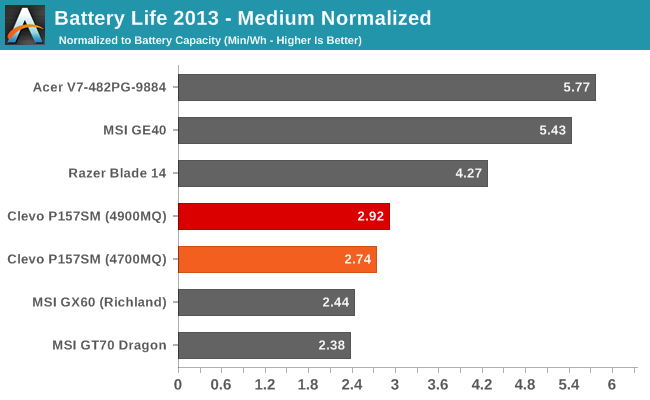Mythlogic Pollux 1613 / Clevo P157SM Review
by Jarred Walton on August 30, 2013 12:00 AM ESTMythlogic Pollux 1613 / Clevo P157SM Battery Life
If there’s one weak spot in terms of objective measurements with Clevo’s gaming notebooks, it’s almost always battery life. Regardless of what power profile or other settings you might use, it’s simply not as good as what we’ve seen with gaming notebooks from other vendors. Most of this is due to the tuning of the BIOS/firmware with a focus on performance rather than power efficiency.
The scores in the charts below include our initial testing results from the MSI GT70, but as one example of what’s possible with further BIOS tuning, with an updated BIOS I measured 373/286/224 minutes on a GT70 – that’s a 63% improvement in our Light testing, a 38% improvement in our Medium testing, and a 23% improvement in our Heavy testing. Performance (gaming performance in particular) dropped slightly in most titles along the way, but reducing performance by a few percent to get significant increases in battery life is definitely a worthwhile compromise on a notebook. Whether or not Clevo can duplicate that feat with an updated BIOS remains to be seen, but past experience isn’t very encouraging.






The good news is that battery life is still better than what MSI achieved with our initial sample, but it’s a far cry from what we’ve seen with other laptops. MSI’s GE40 in particular delivered some stellar results, with relatively similar hardware all told (other than the smaller and lower quality display). Keep in mind that for all of these tests, the discrete GPU is inactive, so we’re only looking at the power and battery life with the iGPU and other components. Also interesting to note is that the choice of an i7-4700MQ or i7-4900MQ doesn't appear to impact battery life much at all.
I’m always asked for battery life while gaming, so I did run some tests there as well. First, as with most gaming notebooks, the dGPU throttles pretty heavily under load. I looped 3DMark11’s demo at 1366x768 “Performance” settings until the battery went dead, and frame rates were around 30-50% of what you’d get while on AC power. The GPU clocks in a game are 850MHz+ on the core and 5000MHz on the GDDR5; unplug the notebook and the core clocks drop to 405MHz while the RAM drops to 1600MHz – not that you need 5000MHz RAM to feed a 405MHz core, but it’s still a major castration of performance under battery power. What that means is that you can actually get nearly the same gaming performance on battery power from the Acer V7 with its GT 750M (which doesn’t throttle as much), or the MSI GE40 (again, less throttling).
Battery life of course is going to be better than if you were running the GPU full tilt, but even with the reduce clocks the P157SM only manages 75-80 minutes before the battery is drained. Put another way, unplugged and running a game the P157SM draws about 63W. Plugged in, I measured 185W power draw at the outlet, so even if we assume an 80% efficiency power brick (and hopefully it’s better than that), the laptop is using around 150W when plugged in, or more than twice as much power. Would someone be happy to get twice the performance but less than half the battery life with a gaming notebook? I doubt it, so the decision to throttle the GPU clocks on DC power is probably the right thing to do.










47 Comments
View All Comments
Meaker10 - Friday, August 30, 2013 - link
It would be interesting to compare the XTU graph of each actually to see how their behaviour is different then. I might have to investigate that when I get the chance.That does not change the fact the 4930MX can run in the MSI at 4.1ghz during game play though. Sure that might not last during full rendering load or prime (stock CPUs will not either in any system including the sager) but it still behaves and just lowers the clock as it hits the power limit (Set to a healthy 75W) rather than temp throttle.
Notmyusualid - Sunday, September 1, 2013 - link
95C sounds about right to me.Speaking for my M18x R2 - If I'm gaming for extend periods (think h o u r s), I run HWinfo64 to force the CPU fan higher than the bios would ordinarily set, and I find 4 cores @ 4.4GHz in High Perf mode to be the most stable for me. 85C is the absolute max I would see in this state, and it is often less. I can run a 4.5GHz, and some run higher, but I'm happy with the stability with 4@ 4.4GHz.
The GPUs I don't overclock, ever.
xtyling - Friday, August 30, 2013 - link
Jarred.. On a $1500 budget and need for a portable (13-15inch form factor) gaming machine... which would you choose.. Digital Storm's Veloce or this Mythlogic Pollux?JarredWalton - Friday, August 30, 2013 - link
The Veloce is just the Clevo W230ST (sold as the Mythlogic Chaos 1313, as well as by most other Clevo resellers -- http://www.mythlogic.com/configure.php?id=147), and it's in a different category as it's smaller and tops out at the GTX 765M. You can get an idea of performance by looking at the Razer Blade 14 numbers, but of course for $1500 you wouldn't be getting GTX 780M in the first place. I believe the W230ST also includes an IPS panel (that's what Mythlogic says at least), so that's actually a nice bonus.For portability at the cost of performance, I think W230ST looks like a good compromise. Gaming at 1080p will need to drop down to ~High detail with no AA in many games, but I would be okay with that. If you can push the budget to $1630, grab one from Mythlogic with the 512GB mSATA SSD. :-)
name user - Friday, August 30, 2013 - link
ah yes, a tramp stampyes i will buy this product, with money, and take it places with me because its portable, with a tramp stamp
because im a goddamn idiot
gnorby - Friday, August 30, 2013 - link
While many Clevo based systems run about the same, dollar-wise, Mythlogic has a policy called the Phoenix Upgrade Policy which means that as long as you own the laptop, you pay 5% over their cost on any upgrade components, and they will install and then run a full test suite (just like when the machine is new) before returning it to you with the new hardware. That's as close to future-proofing as I've found yet.I have a Mythlogic Nyx 17", and since getting mine, my son and nephew both bought theirs. We've all been very pleased with pre-sales support, sales and technical support. These guys are a joy to work with.
Keep in mind that I'm 53, have dealt professionally with computers since the 1980s, and am not easy to impress.
DanNeely - Friday, August 30, 2013 - link
That sounds promising; but my question would be if the extremely high prices that a 3rd party would have to pay for the parts for a DIY an MXM are AMD/nVidia's (distributors?) prices or profiteering my the people putting them up on ebay/etc.I suppose the question to ask if I was in the market for one would be what their price would be to upgrade last years model from a 680 to a 780.
nerd1 - Friday, August 30, 2013 - link
I have found that upgrading MXM GPU is prohibitively expensive and usually it is way easier and cheaper to sell and repurchase a new laptop.rpgfool1 - Friday, August 30, 2013 - link
Any differences between the Clevo P170SM and the Clevo P177SM? I'm looking to get one probably around Black Friday or Christmas. Checking out the various Clevo resellers and vendors and Mythologic seems to be quite friendly, even though their prices are slightly higher. Also looked into PowerNotebooks, Malibal, XoticPC, and LPC-Digital.JarredWalton - Saturday, August 31, 2013 - link
The P170SM and P150SM have slightly different designs, with one less 2.5" drive supported I believe, plus no backlit (tramp stamp) on the touchpad, and the touchpad is Synaptics instead of Sentelic. Basically, all reasonable tradeoffs in my book.